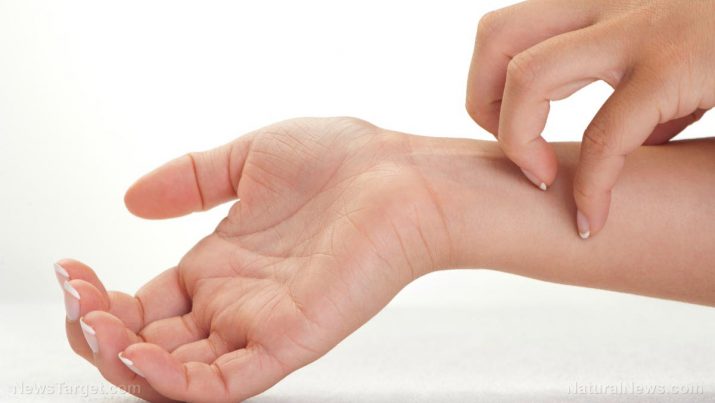
Erythropoietic protoporphyria – causes, side effects and treatments at NaturalPedia.com
Tuesday, April 03, 2018 by Michelle Simmons
http://www.naturalpedia.com/erythropoietic-protoporphyria-causes-side-effects-and-treatments-at-naturalpedia-com.html

Erythropoietic protoporphyria is a rare inherited metabolic disorder that is a result of a deficiency of the enzyme ferrocheletase (FECH), which is due to the mutations in the FECH gene. Because of abnormally low levels of the FECH enzyme, excessive amounts of protoporphyrin build up in the bone marrow, blood plasma, and red blood cells. In turn, the accumulation results in photosensitivity.

Known side effects of erythropoietic protoporphyria
The side effects of erythropoietic protoporphyria may include extreme skin sensitivity to light, anemia, changes in skin pigmentation, and erratic behavior related to sun exposure. A person with erythropoietic protoporphyria may also experience tingling, burning, itching sensation of the skin upon sun exposure, or redness and swelling after a few minutes of skin exposure to direct sunlight.
Since there is no cure for the disorder and it is difficult to manage, complications are common. The complications include coma, gallstones, paralysis, respiratory failure, liver disease and failure, and skin scarring. Moreover, it may cause permanent damage, such as difficulty in breathing that may require continuous oxygen supply, walking problems, anxiety attacks, and scarring.
Body systems harmed by erythropoietic protoporphyria
The main body system harmed by erythropoietic protoporphyria is the integumentary system as it causes the skin to be sensitive to sunlight that causes extreme pain after exposure.
List of foods or nutrients that prevent erythropoietic protoporphyria
There is no information on what specific foods or nutrients can prevent erythropoietic protoporphyria. However, people with the disorder should consume foods rich in calcium and vitamin D, such as milk, yogurt, and cheese, as they are prone to develop deficiencies of vitamin D and calcium because of lack of sunlight exposure.
Treatments, management plans for erythropoietic protoporphyria
There are several treatment and management plans for erythropoietic protoporphyria. Patients with the disorder should avoid sun exposure, wear protective clothing, hats, and use light-opaque titanium dioxide or zinc oxide containing sunscreens. They can also take oral beta-carotene to reduce photosensitivity. Other drugs that can also reduce photosensitivity include afamelanotide. Acute symptoms of erythropoietic protoporphyria can be relieved by taking cold baths or using wet towels, analgesics, and topical and/or oral corticosteroids. Patients who developed decompensated end-stage liver disease may need liver transplant. They should also monitor their vitamin D levels as deficiency of the vitamin is common because they tend to avoid sun exposure, and if levels are low, they should take supplements.
Where to learn more
- Color of your urine reveals about your health
- Fluorescent Light Bulbs Linked with Eczema, Seizures, Migraines, Skin Rashes
- DangerousMedicine.com
- BigPharmaNews.com
- Herbs.news
Summary
Erythropoietic protoporphyria is a rare inherited metabolic disorder that is a result of a deficiency of the enzyme ferrocheletase (FECH).
Erythropoietic protoporphyria causes extreme skin sensitivity to light, anemia, changes in skin pigmentation, tingling, burning, itching sensation of the skin upon sun exposure, and redness and swelling after a few minutes of skin exposure to direct sunlight.
Erythropoietic protoporphyria may result in complications, including coma, gallstones, paralysis, respiratory failure, liver disease and failure, and skin scarring.
Erythropoietic protoporphyria mainly harms the integumentary system.
Erythropoietic protoporphyria can be managed by avoiding sun exposure, wearing protective clothing, hats, and using light-opaque titanium dioxide or zinc oxide containing sunscreens.
Symptoms of erythropoietic protoporphyria can also be managed by taking oral beta-carotene to reduce photosensitivity, taking cold baths or using wet towels, analgesics, and topical and/or oral corticosteroids.
Erythropoietic protoporphyria patients should be watchful of their vitamin D levels.
Sources include:
Tagged Under: Tags: Erythropoietic protoporphyria





